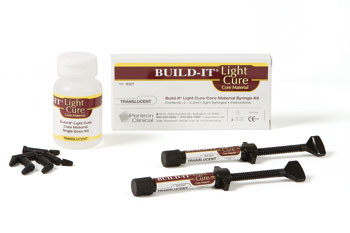Home › Forums › Dental materials › Build-It Light Cure Core Material
Welcome Dear Guest
To create a new topic please register on the forums. For help contact : discussdentistry@hotmail.com
- This topic has 1 reply, 1 voice, and was last updated 12/08/2012 at 3:46 pm by
Drsumitra.
-
AuthorPosts
-
04/05/2012 at 6:17 pm #10480
Drsumitra
OfflineRegistered On: 06/10/2011Topics: 238Replies: 542Has thanked: 0 timesBeen thanked: 0 timesBuild-It Light Cure Core Material
 Core material technology has evolved through cast metal, prefabricated metal, glass ionomer, compomer, and composite resin. Recently, the most popular core build-up materials have been dual-cure composites that could be inserted into the canals and around the post; they could be light-initiated but would self-cure within 5 to 7 minutes. These dual-cure cores were compatible only with fourth-generation adhesives, requiring practitioners using fifth-, sixth-, and seventh-generations to maintain a dedicated adhesive material. Pentron Clinical has introduced Build-It Light Cure Core Material, specifically designed for clinicians who prefer on-command light curing (cures only upon light initiation). The light-cure-only chemistry provides excellent physical properties and is compatible with all fourth-, fifth-, sixth-, and seventh-generation bonding agents. It cures to a depth of 10 mm within 20 seconds of curing time. This eliminates the need for time-consuming (and expensive) layering techniques. It sets to rock-hard consistency and cuts very similarly to natural dentin, and its Bis-GMA-free resin makes it sculptable and nonsticky during insertion, allowing excellent clinical adaptation. The Build-It Light Cure Core Material is available in both syringe and unit-dose delivery modes. The major advantage of light-cure-only resins is that they contain no phosphenes (agents that catalyze dual-curing after mixing or light initiation) in their chemistry. Phosphenes have a serious disadvantage of yellowing over time. In aesthetic cases, a yellowing core may cause aesthetic problems when placing semi or very translucent all-ceramic crowns. Build-It Light Cure Core Material’s excellent handling characteristics allow the clinician to be in complete control of the core procedure from beginning to end.For more information, visit pentron.com.
Core material technology has evolved through cast metal, prefabricated metal, glass ionomer, compomer, and composite resin. Recently, the most popular core build-up materials have been dual-cure composites that could be inserted into the canals and around the post; they could be light-initiated but would self-cure within 5 to 7 minutes. These dual-cure cores were compatible only with fourth-generation adhesives, requiring practitioners using fifth-, sixth-, and seventh-generations to maintain a dedicated adhesive material. Pentron Clinical has introduced Build-It Light Cure Core Material, specifically designed for clinicians who prefer on-command light curing (cures only upon light initiation). The light-cure-only chemistry provides excellent physical properties and is compatible with all fourth-, fifth-, sixth-, and seventh-generation bonding agents. It cures to a depth of 10 mm within 20 seconds of curing time. This eliminates the need for time-consuming (and expensive) layering techniques. It sets to rock-hard consistency and cuts very similarly to natural dentin, and its Bis-GMA-free resin makes it sculptable and nonsticky during insertion, allowing excellent clinical adaptation. The Build-It Light Cure Core Material is available in both syringe and unit-dose delivery modes. The major advantage of light-cure-only resins is that they contain no phosphenes (agents that catalyze dual-curing after mixing or light initiation) in their chemistry. Phosphenes have a serious disadvantage of yellowing over time. In aesthetic cases, a yellowing core may cause aesthetic problems when placing semi or very translucent all-ceramic crowns. Build-It Light Cure Core Material’s excellent handling characteristics allow the clinician to be in complete control of the core procedure from beginning to end.For more information, visit pentron.com.


 12/08/2012 at 3:46 pm #15808
12/08/2012 at 3:46 pm #15808Drsumitra
OfflineRegistered On: 06/10/2011Topics: 238Replies: 542Has thanked: 0 timesBeen thanked: 0 timesThe objective of a post-and-core buildup is primarily to replace missing coronal tooth structure sufficiently to provide adequate retention and resistance for the crown that will eventually restore the function and the aesthetics of the tooth in question.1 The use of posts is still an area of great debate within dentistry. This debate ranges from dentists who only do cast posts, to dentists who use any of a variety of prefabricated systems, to clinicians who do not believe that posts are clinically effective. Within the literature, there are wide ranging studies that could be used to support any of the above beliefs. In the end, clinical experience, common sense, and evidence-based decisions should be the practitioner’s guide as to whether to use a post or not.
In the last decade, the use of prefabricated fiber posts has gained a lot of popularity with dentists. These new systems have demonstrated a modulus of elasticity that closely matches dentin, a reduction of stresses concentrated within the root canal, and reduced incidence of fracture.2-4
The purpose of a post is to retain a core that is needed because of extensive loss of coronal tooth structure; a post is not intended to provide any increase in the strength of the tooth. A post is the anchor to which the core gains additional retention. Fiber posts are able to provide additional retention because they are bonded into place. A fiber post is adhesively bonded into place using a bonding agent in combination with a dual cure resin cement. This combination allows for the resin cement to bond to the dentin of the tooth and the resin reinforced fibers of the posts. The post is then adhesively retained to the core when a composite resin build-up material is used. The synergistic nature of the use of these materials has the potential to create the strongest possible replacement of missing tooth structure.
-
AuthorPosts
- You must be logged in to reply to this topic.